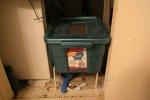firedreams
2010 Research Grant Donor
- Joined
- May 31, 2009
- Messages
- 243
- Reaction score
- 7
- Points
- 0
- Location
- Toronto, ON
- Country
- Canada
- Display Name
- Lydia
Hi all,
I have been keeping a worm bin for the past year in the hopes of maintaining a steady supply of earthworms (which I collect from the garden during the summer). I have them in an approx. 5 gallon rubbermaid bin which has top ventilation and drainage holes in the bottom (pic attached). I fill the bin with layers of newspaper strips, topsoil, and vegetable scraps. I have been having trouble with moisture - every 2 months or so the soil in the bin turns into a gooey smelly muck, and the entire bin must be cleaned out immediately or the worms all die.
Q: Is it normal to have to clean out a worm bin this often? I realize that one problem is probably that my bin is too small. I live in a condo and cannot accommodate a huge worm bin, but I was thinking of increasing the size to 10 or 15 gallons. Would this help? I need it to house 2-300 earthworms (not night crawlers, just small garden earthworms).
Thanks for your help!
I have been keeping a worm bin for the past year in the hopes of maintaining a steady supply of earthworms (which I collect from the garden during the summer). I have them in an approx. 5 gallon rubbermaid bin which has top ventilation and drainage holes in the bottom (pic attached). I fill the bin with layers of newspaper strips, topsoil, and vegetable scraps. I have been having trouble with moisture - every 2 months or so the soil in the bin turns into a gooey smelly muck, and the entire bin must be cleaned out immediately or the worms all die.
Q: Is it normal to have to clean out a worm bin this often? I realize that one problem is probably that my bin is too small. I live in a condo and cannot accommodate a huge worm bin, but I was thinking of increasing the size to 10 or 15 gallons. Would this help? I need it to house 2-300 earthworms (not night crawlers, just small garden earthworms).
Thanks for your help!

